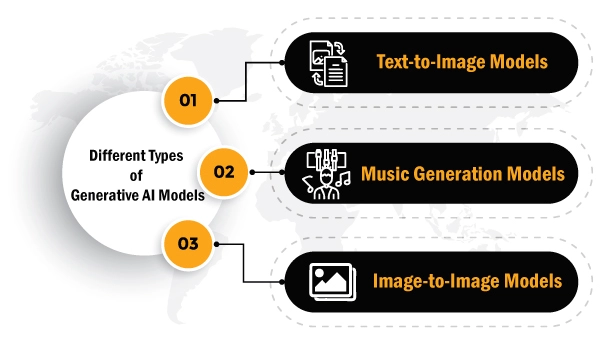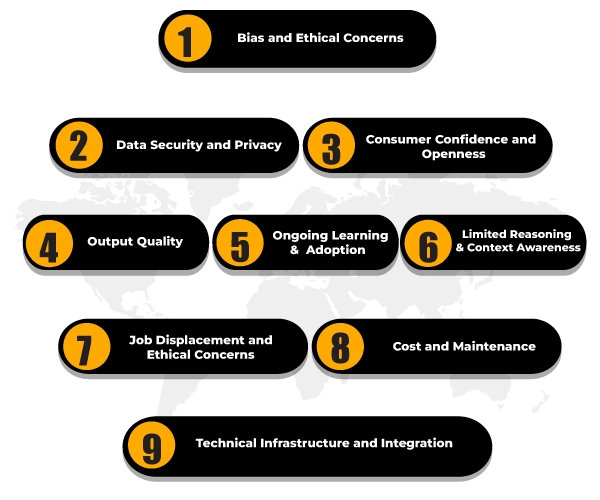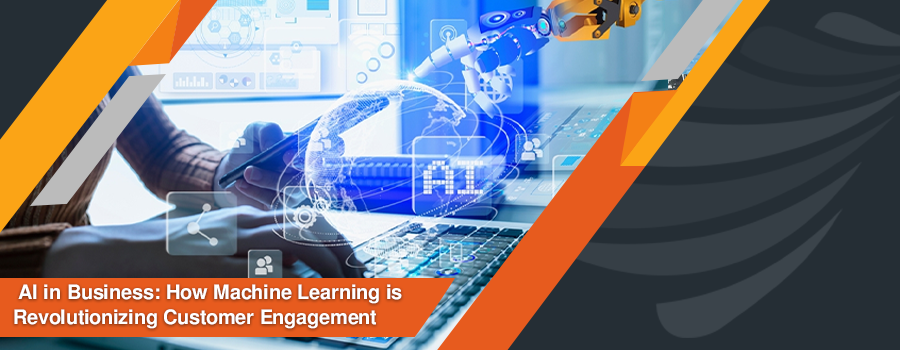Within the dynamic field of artificial intelligence, Generative AI is a noteworthy phenomenon that revolutionizes how the consumer experience is shaped. It provides a wide variety of contextually relevant material, such as dynamic conversational exchanges and personalized product suggestions, Generative AI is now at the forefront of improving business consumer engagement. This blog will examine the significant influence of generative artificial intelligence on the consumer experience as we delve into the complex dynamics of this cutting-edge technology.
What is Generative AI?
One revolutionary aspect of artificial intelligence is generative AI, which includes technology that can create diverse content, including text, images, and audio. New developments have made it easier to create content using intuitive interfaces, which makes it possible to produce high-quality products quickly.
Though its origins date back to the 1960s, the development of Generative Adversarial Networks (GANs) in 2014 marked a turning point for generative AI. While deepfakes and cybersecurity issues are being raised, these machine learning algorithms have made it possible to create convincingly authentic images, movies, audio, opening prospects in the movie dubbing and instructional content industries.
The advancement of generative AI has been fueled by two significant discoveries: transfer learning and the Transformer architecture. In 2017, the Transformer architecture was revealed, revolutionizing the field of natural language processing. Additionally, pre-training and transfer learning enabled models to be tailored to certain domains or tasks. The effect of generative AI extends to healthcare, cybersecurity, entertainment, and content production. It highlights the need for responsible development and prioritizes customer considerations to balance the technology’s potential for good with its ethical drawbacks.
Difference Between Generative AI and Conventional AI
Generative AI, as a subset of artificial intelligence, relies on producing new and creative content. Unlike conventional AI, which relies on predefined rules and explicit programming, generative AI relies on learning patterns from data and producing unique outcomes.
The prominent examples of generative AI are DALL-E and ChatGPT. Generative AI beats conventional AI by producing creative and innovative outcomes beyond predefined examples.
Generative AI Adoption Statistics
According to a recent survey, 29% of Gen Z, 28% of Gen X, and 27% of Millennials already utilize generative AI tools at work, demonstrating that generative AI has earned great importance in the workplace. The sectors most benefitted from generative AI are marketing and advertising (37%), technology (35%), and consultancy (30%). The percentage of generative AI used on a wide scale reached 23% in 2022; by 2025, it is predicted to reach 46%.
Five days after its launch, ChatGPT, OpenAI’s language model, had more than one million users; DALL-E, an image-generating tool, took about 2.5 months to reach the same milestone. In its first launch month, the AI-powered programming tool GitHub Copilot attracted 400,000 users.
According to forecasts, the generative AI industry is expected to develop quickly in the Asia Pacific region, reaching USD 110.8 billion by 2030. The artificial intelligence industry is expected to generate an astounding $1.8 trillion revenue by 2030. These figures demonstrate how generative AI is being used widely and has a great deal of room to grow in various industries.
Different Types of Generative AI Models
Generative AI models fall into many categories, differentiated by the type of information they generate. Generative AI model types include the following:
1. Text-to-Image Models
These models demonstrate their ability to produce visual representations from textual prompts. By giving a text description, a text-to-image model generates an image. For example, instructing to generate an eye-catching cat on a cozy sofa generates an image of a “charming cat lounging on a crimson sofa.”
2. Music Generation Models
These models create music independently or in response to textual cues, demonstrating adaptability. For example, a music generation model may create a piece of music that imitates the style of a particular composer, or it could create a completely original and new piece of music.
3. Image-to-Image Models
These models are focused on changing the style of images. Some examples are turning a black-and-white photo into a color version or turning a painting into a lifelike, photorealistic picture.
How Generative AI Can Enhance Customer Experience
With its inventive powers, generative AI has the power to transform and improve customer experiences in a wide range of businesses. The following are some ways that generative AI might enhance and personalize the consumer journey:
1. Personalized Content Creation
Generative AI creates content tailored to the user’s interests and actions. Businesses can engage clients with material that speaks to them personally by using technology to customize marketing messages, product recommendations, and interactive website content.
Imagine perusing a fashion e-commerce site utilizing “Stylus AI.” Your homepage is exploding with colorful flowery dresses and vintage denim jackets, and it remembers how much you loved bright designs and classic cuts. When you peruse, AI-generated descriptions draw attention to the eco-friendly materials used in your preferred jacket, and a virtual try-on function allows you to preview how the item will fit on your body before selecting add to cart. All the processes, from suggestion to purchase, are customized to your taste because of the wonders of generative AI-powered personalized content generation.
2. Chatbots for Dynamic Engagements
By giving more contextually aware and dynamic responses, chatbots that incorporate generative AI improve consumer engagement. These chatbots provide a smooth and effective customer service experience by understanding complex inquiries, quickly resolving problems, and simulating real conversations.
To understand its application, imagine yourself contacting a telecom provider to learn more about upgrading your mobile plan. You get an immediate and valid response to your query if the company uses a chatbot powered by generative AI like “Spark.”
It examines your past interactions and buying history and uses its natural language processing capabilities to identify your unique demands. It offers thorough details on the available plans and proactively suggests a customized upgrade based on your usage habits. The chatbot adjusts its responses in real-time during the discussion, resulting in a smooth and dynamic exchange that not only quickly and effectively answers your question but also gives you a good and tailored impression of the company’s customer service.
3. Virtual Shopping Assistants
Generative AI can power virtual assistants in e-commerce that can comprehend client preferences, provide product recommendations, and even create virtual try-on experiences. Offering tailored suggestions expedites the purchasing process and increases client happiness.
Imagine using a generative AI-powered virtual shopping assistant to peruse an online fashion store. The one is promptly available in the market is “Style Scout.” It converses with you to learn about your style, makes tailored outfit suggestions, and even allows you to virtually try it via Augmented Reality. It makes your shopping experience feel like a personalized styling session with a close friend.
4. Improved Product Descriptions
Product descriptions can be made more interesting and distinctive by using generative AI. The system makes sure that the descriptions are accurate and customized to attract the interest of target audiences by evaluating consumer feedback and product attributes.
Consider an AI-powered tool for your online store named “Wordsmith” that creates engaging product descriptions. It turns simple product information into fascinating stories that draw attention to special qualities, arouse feelings, and speak to customers’ requirements. Wordsmith turns a plain black backpack into a rugged travel companion for your urban adventures, with ample space for your tech essentials and weather-resistant fabric in seconds.
5. Visual Content Generation
Generative AI is skilled at producing realistic visual content from textual descriptions using models such as DALL-E. This feature enables companies to provide aesthetically appealing and consistent content for marketing brochures, social media posts, and product photography.
Consider an interior designer who uses “DALL-E Studio” to see how a client’s living room would be designed. DALL-E Studio creates a gallery of realistic photos with a few typed prompts: a cozy living room with colorful patterns, a minimalist place bathed in natural light and flora, or a comfortable living room with luxurious velvet seats. When the client sees their ideal environment realized right away, design choices become more inspired and intuitive.
6. Personalized Education Environments
Generative AI can improve student experiences in educational contexts by producing individualized course materials. Each learner’s needs may be met with technology since it can tailor exercises, quizzes, and content to suit individual learning styles.
Envision an educational platform called “Adaptive AI” that customizes classes based on learners’ requirements and interests. It evaluates their learning preferences, areas of strength and weakness, and curriculum to design individualized learning paths. Adaptive AI provides personalized feedback and support through interactive exercises that adjust in real-time, making learning more engaging and encouraging for all learners. This contrasts with a one-size-fits-all approach.
7. Interactive User Interfaces
The application of generative AI can aid the creation of extremely interactive and user-friendly interfaces. Generative AI enables mobile app and website interfaces that dynamically adjust to user activity, making the user experience more engaging and intuitive.
One of the AI fitness apps is “Flow Lab,” which generates workout plans that change based on your preferences, energy level, and the equipment you have accessible. Personalized encouragement and feedback are provided during the session, and it makes exercise recommendations based on your goals and mood, as well as real-time intensity adjustments depending on heart rate. It keeps you motivated and involved by working out like a dynamic interaction between you and the app.
8. Dynamic Email Marketing Campaigns
One of the most important aspects of client involvement is customizing email campaigns for everyone. With consumer data analysis, generative AI can produce personalized email content, making conversations with clients more engaging and relevant and strengthening bonds between them.
One example of an AI marketing tool is ‘Optimail’. It discovers your subscribers’ preferences and creates tailored content and timing automatically. It increases engagement, conversions, and your inbox reputation by driving social media shares, enticing product recommendations, and automating everything. It’s your email whisperer making every message a victory for you personally.
9. Voice Bots for Interaction
Generative AI-powered voice bots are smart conversational interfaces that change how businesses connect with customers. These chatbots mimic human communication by utilizing machine learning and natural language processing to interact with users. These bots can interpret and react to human inputs in real-time through generative AI, guaranteeing contextually suitable conversation. This feature is especially useful in consumer self-service scenarios, as these bots may quickly respond to inquiries, offer information, and even carry out specific activities, drastically reducing the time it takes to resolve issues.
Artificial intelligence is integrated into speech bots, enabling natural and hands-free interactions between users and systems. Voice-activated bots, such as “ShopBuddy,” provide a more user-friendly and accessible interface using voice recognition technology to comprehend and react to spoken commands. Whether included in automated phone systems, virtual assistants, or other applications, voice bots enhance customer engagement by offering a user-friendly and productive mode of communication.
The ongoing developments in generative AI augment these bots’ capacities, allowing them to interpret complex commands, preserve context, and provide customized answers, thus improving customer service standards overall.
10. Facial Recognition
As a Gen AI feature, facial recognition improves customer experience by offering quick and safe identification in various situations. For example, banking makes transactions more secure by replacing conventional methods of identity recognition with facial recognition, guaranteeing a smooth and convenient experience for clients.
Apple’s Face ID function is one example of face recognition technology. Facial recognition algorithms are used by Face ID, an integrated feature of iPhones and iPads, to safely authenticate users. The TrueDepth camera takes pictures and records facial traits to create a personalized facial map when the user looks at it. Then, this map is compared to the face data recorded on the device using advanced algorithms. The device is unlocked and offers a secure and seamless user experience if there is a match. In addition to improving the device’s security, Face ID streamlines the authentication procedure and gives users a quick and easy way to access their tablets and smartphones.
11. Interactive Voice Response (IVR)
Interactive voice response (IVR) systems are being revolutionized by synthetic voice creation powered by generative AI, which produces speech that closely mimics human articulation. Customers can communicate with brands more engagingly and naturally because AI-generated audio communications mirror the subtleties of human speech.
This technology helps companies create a unified and identifiable brand identity by maintaining a consistent and brand-aligned aural experience across various customer touchpoints. Generative AI in speech production enhances communication quality and adds to a more individualized and smooth customer experience, whether used to guide customers through menu options or deliver automated messages.
12. Automated Content Drafting
Generative AI is a powerful tool for marketing automation for writing engaging ad copy, social media postings, and product descriptions. Companies can optimize content creation procedures using sophisticated language models such as ChatGPT.
For instance, ChatGPT can create interesting social media content that appeals to target markets while maintaining a tone and aesthetic consistent with company identity. This improves the content’s impact and relevancy while saving the marketing team’s time. Companies can maintain a consistent and appealing communication strategy across several media, thereby increasing the success of their marketing efforts, thanks to generative AI’s capacity to change its language to suit varied marketing circumstances.
13. AI-backed Personalization
With AI-backed personalization, profiles are refined by analyzing previous interactions, purchases, and preferences. This technology uses information on user actions, including views, clicks, and transactions, to improve the accuracy of product and content suggestions.
For example, a generative AI platform could design a personalized shopping aisle for every user, customizing suggestions according to their tastes. This degree of customization helps improve consumer happiness and loyalty and creates a more pleasurable and relevant purchasing experience.
Generative AI ensures that recommendations are up to date and accurately represent changing customer preferences by continuously learning from and reacting to individual behaviors. This helps organizations optimize their entire customization approach.
Challenges While Using Generative AI for Enhancing Customer Experience
Although generative AI has much potential to improve consumer experiences, a few obstacles must be overcome before it can be successfully implemented. Among the principal difficulties are:
1. Bias and Ethical Concerns
Generative AI algorithms may unintentionally pick up biases from training data, which could result in biased suggestions or answers. Careful monitoring and mitigation techniques are necessary to ensure the ethical usage of AI and to remove prejudice.
2. Data Security and Privacy
Managing private client information presents security and privacy issues. Companies must have strong security measures to safeguard client data and adhere to data protection laws.
3. Consumer Confidence and Openness
Consumers may be wary of or uncomfortable with interactions powered by AI. Transparency on the application of generative AI, an explanation of data usage, and the provision of opt-in/opt-out options for AI-powered features are all necessary to build trust.
4. Output Quality
It’s critical to produce excellent, contextually relevant information. Sometimes, the output generated by generative AI models is inconsistent or doesn’t fully grasp the user’s purpose, which can result in worse-than-ideal user experiences.
5. Ongoing Learning and Adoption
For generative AI models to remain current and useful, they require frequent updates. Continuous learning requires specialized tools and procedures to adjust to shifting consumer tastes and behaviors.
6. Limited Reasoning and Context Awareness
Certain generative AI models may find it difficult to comprehend the larger context of a given scenario, leading to the production of outputs that lack context or make no sense at all. This may result in unsatisfactory and sometimes harmful experiences for customers.
7. Job Displacement and Ethical Concerns
Certain industries may see job losses due to generative AI’s task automation. Furthermore, there are moral questions about consent and transparency when AI influences consumer behavior.
8. Cost and Maintenance
Creating and managing strong generative AI models can be costly and require high technical know-how. Smaller organizations may find it difficult to access and use this technology.
9. Technical Infrastructure and Integration
Complex generative AI models may require processing power beyond what the current IT infrastructure can provide. Integrating these models with current systems can be difficult and time-consuming.
Future Implications of Generative AI
The fact is that generative AI has the power to improve virtual and augmented reality experiences, speed up scientific discoveries, and automate coding chores. These traits highlight its transformative potential and its far-reaching effects on how humans work, learn, and interact with technology in the future. With its diverse applications, generative AI is poised to revolutionize digital experiences by combining efficiency, creativity, and customization.
When used with virtual reality, generative AI may produce immersive worlds that change dynamically in response to user interactions and choices. Due to this synergy, lifelike simulations can be created—from virtual environments with dynamic characters to realistic scenarios—offering users a never-before-seen degree of engagement.
Furthermore, as generative AI develops, new avenues for comprehending human behavior and preferences become possible through its integration with advanced computing power and data collection. Artificial intelligence (AI) can gain insights into individual and group behaviors by evaluating enormous datasets from user interactions in virtual environments. With the use of this data-driven strategy, experiences may be customized to better meet user expectations, resulting in the creation of unique and flexible virtual environments.
The Key Takeaways
Generative AI is transforming customer experience by customizing interactions and influencing content creation. Now, customer support is streamlined by chatbots, which use generative AI to provide prompt, contextually relevant responses. Future applications of the technology will open new avenues for businesses, allowing them to win customer trust and provide the best experience. However, gaining customers’ trust depends heavily on ethical factors like prejudice mitigation and how they balance automation and human touch.







